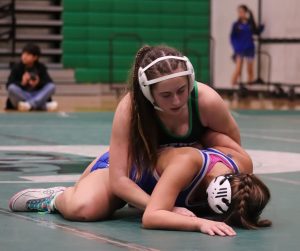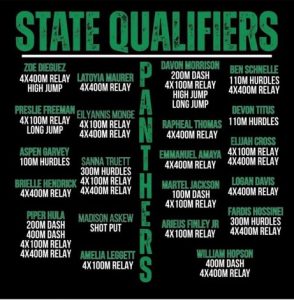Page 1 – Neutral classrooms now the goal: Classroom displays under scrutiny
April 12, 2023
In Derby classrooms, displaying a pride flag is now the same as a Nazi flag.
The IFA Classroom Displays policy was passed 6-0 by the Derby school board at the March 13 meeting, and under the new policy, pride flags are among the items that can no longer be displayed in district classrooms.
“The main point of the new classroom display policy is to ensure that public schools have neutral classrooms,” board president Michael Blankenship said. “As a public school, classroom environments should be neutral so that all feel welcome and ready to learn, focused on the subject being taught.”
This policy was recommended by the Kansas Association of School Boards, which sends possible updates yearly. But some faculty and students question what neutral actually means.
“I think that the IFA Classroom Displays policy is poorly worded,” teacher Nathan Whitman said. “All students should feel welcome in their classrooms and know that it will be a positive educational climate for learning. Unfortunately, the policy itself may hurt the climate of Derby Public Schools.”
In the opening of the policy, it states that while a teacher determines the materials used, they “should be grade-level appropriate and align with the subject-matter being taught.”
Whitman states that on its own, there’s nothing wrong with it being grade-level appropriate, but when paired with the latter of the policy is when it becomes problematic.
“…‘(C)lassrooms are not public forums for the display or distribution of political, religious, or personal viewpoints’ and that employees are not to promote said viewpoints, it becomes quite subjective and open for abuse of power or creating problems where none actually were to begin with,” Whitman said.
Which brings the discussion back to pride flag vs. Nazi flag.
Students want to know what exactly this means. Does a Nazi flag meant to inspire hate fall in the same category as a pride flag? Senior Kaia Mei said they should not. A pride flag, she said, means feeling supported in a classroom.
“(I felt safe) in Lori Schock’s room,” she said. “She is very supportive of everyone and their futures. She cared about one-on-one with her students.”
Mei even left a life-size capybara in the cutout in the classroom.
But does that fall under the policy? It’s unclear.
College and sports posters, Marvel figurines, holiday decor, stuffed animals — would these be considered unnecessary to a classroom? What about Christmas trees? Or Buddha statues? Are they considered religious, political, personal?
Most teachers have personal items in their classrooms, such as family photos, cards and posters. These items not only make teachers’ spaces feel comfortable to them, but also help with relationship building — letting students know they are people, too.
If a teacher is LGBTQ or in an interracial relationship, that teacher might have a photo that reflects that. Is that considered political under this policy?
“By enacting this policy, we’re telling many of our students that they are not welcome; that there’s something wrong with them,” Whitman said. “It’s not an overt statement. It’s a statement through erasure. People are born LGBTQ+; people are born Black, Asian/Pacific-Islander, Native American, LatinX; people are born with various (dis)abilities.”
If an LGBTQ teacher cannot display a photo that depicts a relationship that the Board of Education deems political, some wonder where the line will get drawn. Can straight teachers display their family photos?
“The immutable characteristics of their identities are not political statements,” Whitman said. “They have the right to exist in our hallways and to be represented in our classrooms.”
For a policy, this means marginalized groups become even more marginalized.
“People choose to be racist, homophobic, transphobic, and ableist,” Whitman said. “By instating this policy, we’re giving those individuals a free-range hall pass and forcing the identities of our most vulnerable student populations to an expulsion hearing.”







Melissa • Apr 18, 2023 at 9:01 pm
I totally agree with Mr. Whitman. We’re silencing, erasing, and punishing those who are already marginalized with this policy. My middle schooler is more afraid than ever to go to school right now, because their identity is seen as a belief or an agenda rather than who they are. And who they are is seen as wrong, offensive, taboo, or disgusting. How is my child supposed to go to school and feel safe and be able to focus on academics when they are literally scared for their life?